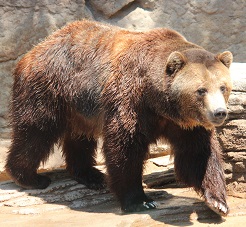What Do You Know about Brown Bears?
 Ursus arctos (Brown Bear)
Ursus arctos (Brown Bear)
This large Bear species ranges in areas of Eurasia, North America and Canada. Populations across Eurasia have declined and in some areas, like the United Kingdom, are completely wiped out. Most abundant populations belong in Canada, Russia and North America where there is more natural land available. Depending on their location, Ursus arctos distribute across open tundra, forested areas and mountain regions.
Characteristics
Ursus arctos are large, robust animals with strong limbs and powerful jaws. Their skull is large, with muscular, shoulder hump and they can reach up to 8ft tall when standing on their hind legs. Their claws are straight and long, and unlike Black Bears, the claws are blunt. Physical size ranges geographically with the American species being larger in the North, particularly in Alaska. Eurasian species are larger across the East in Russian regions, and size decreases nearer the West. Colour and hair also varies geographically, ranging from dark brown, black to cream.
Behaviour
This species is generally solitary, except for mother and cubs, and during breeding season. Areas where populations are dense, Bears will come together for feeding, and it is thought that they show dominance hierarchy in these situations and exhibit aggressive displays. Although brown Bears mark their territory these ranges can overlap, and territorial aggression is not usually displayed. Reproductive behaviours are usually polyandry, with the female mating with many males during her cycle. Males bears may fight for a female, and some may even guard his female in the hope it is his genes that gets carried on. Cubs will usually stay with the mother for two and half years, and males play no parental role. Females will only mate again once cubs are independent, usually every three years.
Brown Bears are seasonal omnivores and their diet mainly consist of what is readily available. This can include; carrion, berries, fruits, roots, bulbs, vegetation, fungi, invertebrates, small mammals, salmon and larger mammals such as moose, goats and elk.
Threats
Ursus arctos are not endangered and are of least concern, although their populations in certain areas are lower than others. The main threats to their population across Eurasia is habitat loss and man. Brown Bears have been exploited over many years and used in entertainment. Young cubs have been painfully trained to dance in streets, and many are caged in small cages as a tourist attraction in restaurants and fuel stations. There are stricter laws coming into place across many regions with many Bears being rescued and provided with sanctuary. Brown Bears are also hunted for sport, fur and meat across North America, Canada and parts of Eurasia. For centuries, Bears have been used for ‘baiting’ in dog sport in many cultures, and still goes on today in Russia. Although not the usual species, Brown Bears have also been hunted for their gallbladder for use in Asian medicine.
Sub Species
There are many subspecies of Ursus arctos, and it can get confusing with changes occurring. Although they are the same species, there are alterations both physical and geographical.
Ursus arctos arctos (Eurasian Brown Bear)
Ursus arctos alascensis (Alaskan Brown Bear)
Ursus arctos collaris (East Siberian Brown Bear)
Ursus arctos syriacus (Syrian Brown Bear)
Ursus arctos horribilis (Grizzly Bear)
Ursus arctos dalli (Dall Island Brown Bear)
Ursus arctos middendorffi (Kodiak Bear)
Ursus arctos sitkensis (Brown Bear of ABC Islands, Alaska)
Ursus arctos beringiansus (Kamchatka Bear)
Ursus arctos isabellinus (Himalayan Brown Bear)
Ursus arctos pruinosus (Tibetan Blue Bear)
Ursus arctos lasiotus (Ussuri Brown Bear)
From our Carnivore book - click here